|
|
|
Sort Order |
|
|
|
Items / Page
|
|
|
|
|
|
|
| Srl | Item |
| 1 |
ID:
134019
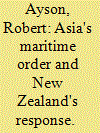

|
|
|
|
|
| Publication |
2014.
|
| Summary/Abstract |
Robert Ayson comments on the South China Sea. Asia's regional security and New Zealand foreign policy
as the powers jostle in a more competitive Asia-Pacific region, it may seem counter-intuitive to call for a clearer New Zealand position on the South China Sea disputes. But even as regional tensions grow, Wellington can stick up for its principles without joining a chorus of China criticism. Under the key government, New Zealand's alignment with the United States is becoming more pronounced through a series of small but cumulatively important steps. this makes it even more important for New Zealand's policy to be staked out clearly, including in written from accessible to the public discussion.
|
|
|
|
|
|
|
|
|
|
|
|
|
|
|
|
| 2 |
ID:
128283
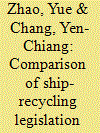

|
|
|
|
|
| Publication |
2014.
|
| Summary/Abstract |
This article discusses the Chinese legal framework in relation to ship recycling and suggests that the various legislation, standards, and opinions provide disorderly and nosystematic regulation. A uniform law specifically regulating the ship-recycling industry should be adopted by China, with a single competent authority empowered to supervise ship-recycling activities, that will effectively implement the 2009 Hong Kong International Convention for the Safe and Environmentally Sound Recycling of Ships.
|
|
|
|
|
|
|
|
|
|
|
|
|
|
|
|
| 3 |
ID:
133071
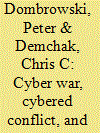

|
|
|
|
|
| Publication |
2014.
|
| Summary/Abstract |
It has been well over a decade since the first “prophets” of information warfare proclaimed a new age of conflict fought not just on air, sea, and land but with electrons in what came to be known as “cyberspace.”1 Since these early predictions, many incidents have confirmed that criminals, random hackers, and government-sanctioned specialists can wreak havoc on governments, military communications systems, and corporations. The Stuxnet worm alone helped delay-by months, perhaps years-the long-standing efforts of Iran to acquire sufficient nuclear material to build nuclear weapons.2 Recent revelations of hacking campaigns against such publications as the Wall Street Journal and New York Times have broadened concerns to include even the integrity of American democratic institutions.3 Meanwhile, the commander of U.S. Cyber Command has characterized cyber attacks designed to gain access to the intellectual property of American corporations as the “greatest transfer of wealth in human history.”
|
|
|
|
|
|
|
|
|
|
|
|
|
|
|
|
| 4 |
ID:
133694
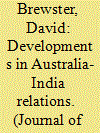

|
|
|
|
|
| Publication |
2014.
|
| Summary/Abstract |
India and Australia have the potential to become important strategic partners in Asia as part of a coalition that could help manage the changing balance of power in the region. But while India and Australia share many strategic interests, both countries still have a lot to learn about how to get along with each other. Some might even see them as the odd couple of the lndo-Paci?c. This paper looks at recent developments in the relationship in the areas of security, politics and economics, and the prospects for a closer partnership under the new Modi government.
|
|
|
|
|
|
|
|
|
|
|
|
|
|
|
|
| 5 |
ID:
126690
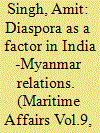

|
|
|
|
|
| Publication |
2013.
|
| Summary/Abstract |
Myanmar' is going through an unprecedented political and socio-cultural trans- formation. During the past five decades of military rule, the country witnessed supprasion of democratic norms/institutions, human rights violations, armed insurgencies by the sidelined ethnic minorities, detention of the opposition activists and leaders, especially the Nobel Peace laureate Ms Aung San Suu Kyi and the economic policies enforced by the junta, and left most of the common people impoverished, including the Indian Diaspora.
|
|
|
|
|
|
|
|
|
|
|
|
|
|
|
|
| 6 |
ID:
133693
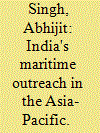

|
|
|
|
|
| Publication |
2014.
|
| Summary/Abstract |
In the past few years, New Delhi's drive to improve maritime relations with East and South East Asia has acquired a frisson of urgency. India's "Look-East" Policy, a largely trade and commerce oriented framework guiding interactions with nations to lndia's East, has now acquired a prominent nautical edge. With increased maritime forays and a clear articulation by the political leadership, ofthe principle of "freedom of navigation" and an "open and inclusive" architecture of global maritime security, New Delhi has shown it is inclined to treat the Western Pacific as a theatre of commercial and maritime security interests.
|
|
|
|
|
|
|
|
|
|
|
|
|
|
|
|
| 7 |
ID:
133695
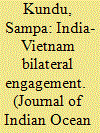

|
|
|
|
|
| Publication |
2014.
|
| Summary/Abstract |
Both India and Vietnam belong to a region that holds enormous potential, but also many challenges. We have a strong convergence of interests in working together, and with others in the region, for a stable, peaceful and prosperous Asia. ....Vietnam's emergence as one of the most vibrant economies in the Asia Pacific region is greatly welcomed by India, especially because we regard Vietnam as a trusted and privileged strategic partner and an important pillar of our Look East Policy".
|
|
|
|
|
|
|
|
|
|
|
|
|
|
|
|
| 8 |
ID:
117150
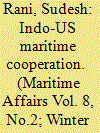

|
|
|
|
|
| Publication |
2012.
|
| Summary/Abstract |
In 1991, after the denouement of the Soviet Union and the end of the bipolar world, major changes took place at the international level. In the wake of these changes, India and the US had to re-adjust their policies and relations that led to cordial India-US relations. Maritime relations were not immune to these winds of change. In the maritime domain, India has adopted a different attitude towards the US presence in the Indian Ocean as compared to the Cold War period. The United States has also recognized India as a major security provider in the Indian Ocean Region (IOR) as the Indian Navy is the largest force in the region. Through the maritime cooperation, both nations can provide the secure and stable environment in the IOR, which is the stated aim of both the countries. In this regard, this paper tries to analyse India-US maritime relations during the Cold War era as well as the post-Cold War period.
|
|
|
|
|
|
|
|
|
|
|
|
|
|
|
|
| 9 |
ID:
133070
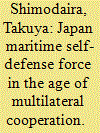

|
|
|
|
|
| Publication |
2014.
|
| Summary/Abstract |
Isaiah Berlin's essay The Hedgehog and the Fox-made famous by the adage "The fox knows many things, but the hedgehog knows one big thing"-explores the pros and cons of a highly focused defense strategy.1 The hedgehog curls up in a ball and defends itself. Hiroshi Doi, former professor at the National Defense Academy of Japan, advocates a "hedgehog-style defense" for Japan, claiming that the country's postwar security policies can still defeat any "sly fox" confronting the nation.2 However, given the emergence of an increasingly complex global security environment, it may be argued that Japan's "defense-only defense policy" is no longer valid. Indeed, must Japan remain a hedgehog forever?
|
|
|
|
|
|
|
|
|
|
|
|
|
|
|
|
| 10 |
ID:
130872
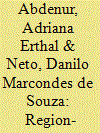

|
|
|
|
|
| Publication |
2014.
|
| Summary/Abstract |
Far from being 'naturally' delineated by geography or bound solely through shared culture, regions are actively constructed by states and other actors pursuing specific interests. In this article, we analyse the region-building efforts of two rising powers - Brazil and India - as they work to project power and enhance their influence within the Atlantic and Indian oceans, respectively. Through a comparison of their behaviours within their maritime spaces - including naval build-up, international cooperation, and efforts to revive institutions such as ZOPACAS and IOR-ARC - we argue that Brazil and India are paying increasing attention to oceanic rims, albeit for somewhat disparate reasons. While India is increasingly concerned with the role of China within the Indian Ocean, for which it has had to rely on US support, Brazil is primarily driven to protect its oil and to minimise the role of the US and NATO in the South Atlantic. In both spaces, however, the rise of so-called non-traditional threats, including piracy, has further motivated these states' maritime power strategies. The analysis suggests that, within the context of the post-Cold War period, rising powers have begun redefining their strategic regions in terms of their maritime perimeters as a way to project power and influence beyond their continental vicinities.
|
|
|
|
|
|
|
|
|
|
|
|
|
|
|
|
| 11 |
ID:
128285
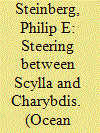

|
|
|
|
|
| Publication |
2014.
|
| Summary/Abstract |
Heightened attention is being paid to the Northwest Passage, the waters that flow among the islands of northern Canada and that, in the next decades, may be amenable to commercial navigation. Most debates regarding the Passage's legal status focus on Canada's contention that it is its internal waters and the United States' contention that it is an international strait. This article proposes that a designation of the Passage as Canada's territorial sea would be as legally robust as the internal waters or international strait designations while satisfying both Canada's and the United States' political objectives.
|
|
|
|
|
|
|
|
|
|
|
|
|
|
|
|
| 12 |
ID:
133069
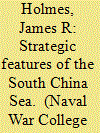

|
|
|
|
|
| Publication |
2014.
|
| Summary/Abstract |
The South China Sea is a semienclosed sea at the intersection between East Asia and the Indian Ocean region. It exhibits characteristics similar to the Mediterranean Sea and the Caribbean Sea, as well as some revealing differences. Both the similarities and the differences commend sea-power theorist Alfred Thayer Mahan's analysis of the Gulf of Mexico and the Caribbean Sea to presentday students and practitioners of maritime strategy. Mahan classified strategic features-especially prospective sites for naval stations-by their positions, strengths, and resources. This article adds a metric to his analytical template, namely, the state of relations with countries that host naval bases. He applied much the same framework to narrow seas, such as international straits, while also sizing up these passages' widths, lengths, and difficulty of transit. Here too an element warrants adding, namely, the underwater terrain-its topography and hydrography.
|
|
|
|
|
|
|
|
|
|
|
|
|
|
|
|
| 13 |
ID:
133085
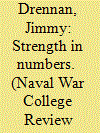

|
|
|
|
|
| Publication |
2014.
|
| Summary/Abstract |
You are a tactical commander tasked with a mission to seek out and destroy one of the enemy's premier capital ships in his home waters. You have two potential striking forces at your disposal: a world-class surface combatant of your own with a 99 percent probability of mission success (Ps = 0.99) or a squadron of eight independently operating, missile-carrying small combatants, each with a chance of successfully completing the mission no better than a coin flip (Ps = 0.5). Do you go with the almost sure thing and choose to send in your large combatant? As it turns out, the squadron of small combatants has an even higher overall Ps but let us now assume that you have advanced to operational commander. You might have more concerns than just overall Ps. What are the defensive and logistical requirements for each option? How much fleet investment are you risking with each option? What will it cost to replace the asset(s) if lost? What capability does the striking force have after successful enemy action (i.e., resilience)? An analysis of these factors, intentionally designed to disadvantage small combatants, is actually overwhelmingly in their favor. The results verify what naval strategists and tacticians have long known-that for certain offensive missions, an independently operating group of even marginally capable platforms can Naval War College Review Vol.67, No.1; Win.2014: p.119-124 Was there something unique to the Japanese that lost them the battle of midway?
|
|
|
|
|
|
|
|
|
|
|
|
|
|
|
|
| 14 |
ID:
133072
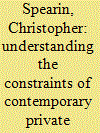

|
|
|
|
|
| Publication |
2014.
|
| Summary/Abstract |
For the secretary-general of the United Nations, Ban Ki-moon, contemporary piracy is nothing less than a "global menace." There are several piracy "hot spots" the world over, each with its own dynamics, but it is Somali piracy that in recent years has particularly caught the attention and raised the ire of states, shippers, and international organizations. International Maritime Organization (IMO) statistics reflect the quantitative dominance of Somali piracy. In 2010 and 2011, the number of alleged attacks in international waters off East Africa and on the Indian Ocean (into which Somali pirates now venture) was 84 percent of the global totals in each year. In 2012, owing to developments both on land and at sea, the Somali weighting declined, but it was still a considerable 54 percent of global totals.
|
|
|
|
|
|
|
|
|
|
|
|
|
|
|
|
|
|
|
|
|